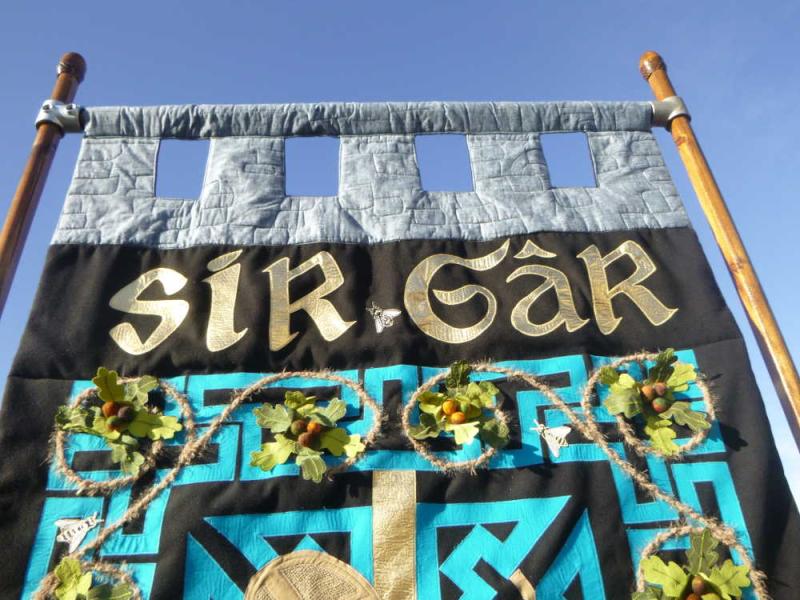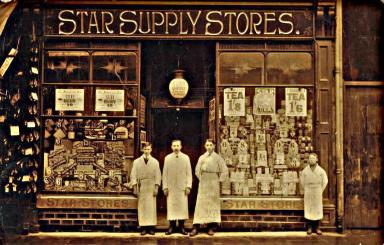Tagged: carmarthenshire

The original idea for a banner for every county in Wales was conceived by Gwenno Dafydd. Her vision was of hand-made banners the size of the coal mining lodge banners, based on the words and images of the Saint David’s Day Anthem, Cenwch y Clychau i Dewi – Ring out the bells for Saint David (Lyrics: Gwenno Dafydd. Music: Heulwen Thomas) and elements of local county history with the aim that they be paraded every Saint David’s Day in their respective local communities.
The first of these banners was the Pembrokeshire Banner, which is on permanent display in the East Cloister, Saint David’s Cathedral, Pembrokeshire. Every year the Pembrokeshire Banner is paraded around the Cathedral in the Saint David’s Day Service by the Head Boy and Head Girl of Ysgol Dewi Sant whilst the children of Ysgol Bro Dewi Primary School sing the Saint David’s Day Anthem.
The second of these County Banners is the Montgomeryshire Banner. Two textile artists Patricia Huggins and Angela Morris designed and made the banner to depict life in Montgomeryshire and the legacy left by St David. Contributions were also made by Pamela Higgs (drawing of Market Hall), Mavis Jones (Needle lace flowers), Shirley Kinsley (dove), Maureen Morris (dyed silk fabric) Also featured are elements from the tomb of the Herbert family to be found in the church of St Nicholas in the old county town of Montgomery.
Montgomeryshire St David's Day Banner
The third County Banner is the Carmarthenshire Banner and it was designed by Eirian Davies from Whitland and the fine handwork was done by Meinir Eynon from Gwm-Miles. The wooden frame supporting the banner and the wooden acorns on the top of the poles have been made by Denzil Davies from Whitland. The bells have been adapted by Dylan Bowen from Pant-bwlch near Newcastle Emlyn and Natalie Dennis, an ex-student from the Trinity Art Department embroidered the bees (University of Wales Trinity Saint David) Gwenllian Beynon of the Trinity Art Department was very supportive throughout the whole banner making development.
It was created to be paraded in the Carmarthen town Saint David’s Day Parade and will be carried for the very first time on the 24 th February 2017 by Gwenno Dafydd and Eirian Davies in the second town parade.
Some of the symbols The stones across the top and bottom represent castles and bridges across the county. Some of the most obvious examples would be Dinevor Castle and the Cynghordy Aqueduct.
The gold colour represents the gold mines of Dolaucothi.
The black colour represents the cover of the Black Book of Carmarthen and the coal industry in the East of the county.
The triangular shape in the middle is a Celtic symbol (Triskele /Triskelion) that can be seen in the Book of Llandelio (St. Chad’s Book or the Lichfield Gospels).
The coracles are a sign of the ancient craft which is connected to the Taff, Tywi and Teifi rivers.
In the middle of the net the circle formed represents the famous Glass House in the Welsh National Botanical Gardens in Llanarthne.
The oak represents the wizard Merlin’s oak. In addition see the beautiful hand carved acorns on top of the poles that carry the banner.
You can see the blue Celtic patterns on Eiudon’s Celtic Cross, a cross from Llan -Sannan-Isaf, Llanfynydd.
The blue colour represents water as Saint David was also known as Dewi Ddyfrwr (The water drinker) The blue also represents the lakes in the tales of ‘Llyn y Fan Fach’ (lake of the small place) and Llyn Llech Owain.(Llech Owain’s lake)
The bees are part of the tales about Saint David and also make a very prominent appearance on the Pembrokeshire Banner. They have been added to the Carmarthenshire Banner to symbolise the fact that Saint David’s message has spread from the city of Saint David to Carmarthen.
The bells play an important part in the Saint David’s Day Anthem (Ring out the bells for Saint David) and there are five bells, each one representing the five ‘cantref’ or ‘hundred towns’ or areas of Carmarthenshire, that of Cantref Gwarthaf, Cantref Emlyn, Cantref Mawr,(Big) Cantref Bychan (Small) and Cantref Eginog. The raw appearance of the bells also represent the tinplate and steel industries of Llanelli.
© Gwenno Dafydd & Eirian Davies. 24 th February 2017.
...
...

Gwenno Dafydd - St David's Day Ambassador To The World
Gwenno Dafydd is the instigator of the Saint David's Day Anthem (Lyrics: Gwenno Dafydd Music: Heulwen Thomas) which was launched by The Presiding Officer of the Welsh Assembly Government, Lord Dafydd Elis Thomas in 2008. She has been promoting and developing Saint David's Day activities worldwide since 2006 when the Saint David's Day Anthem 'Cenwch y Clychau i Dewi' (Ring out the bells for Saint David) was performed in public for the very first time in the National Saint David's Day Parade in Cardiff. She has instigated the tradition of 'County Banners' throughout Wales to celebrate Saint David's Day. This year, the first County Banner, The Pembrokeshire Banner, which is kept on permanent display in the East Cloister in Saint David's Cathedral, will be joined by two new County Banners, those of Montgomeryshire and Carmartheshire.
The Saint David's Day Anthem, which will this year be sold from the very prestigious Ty Cerdd website, patron Karl Jenkins, alongside the music of Welsh composers such as Grace Williams, William Mathias, Morfydd Llwyn Owen and Gareth Glyn. The Saint David's Day Anthem has been performed not only in Wales but also numerous times in Canada, Los Angeles, Patagonia, Disneyland Paris and the Houses of Parliament. Every year the Pembrokeshire Banner is paraded around Saint David's Cathedral whilst local school children sing the Saint David's Day Anthem.
She has created an Iphone App to learn the Welsh National Anthem and is the author of 'Stand Up & Sock it to them Sister. Funny Feisty Females' which had been described by Funny Women, the UK's leading female comedy community as 'the ultimate canon of female stand-up comics'. She is a Leadership and Public Speaking Coach and works extensively via Skype and even has some clients in Los Angeles.
...
Back to Welsh Literature page >
AmeriCymru spoke to Steve Adams. Steve is a journalist currently researching the unsolved 1921 murder of shopkeeper Thomas Thomas at Star Stores in the Carmarthenshire village of Garnant.
Follow his progress on his blog:-
...
AmeriCymru: Hi Steve and diolch for agreeing to this interview. When did you first become interested in the murder of Thomas Thomas?
Steve: As chief reporter of the South Wales Guardian, the Ammanford-based weekly newspaper, I’m always on the look-out for stories with an Amman Valley link, particularly those which allow me to explore two of my other great interests – Welsh history and historic crime. So, when in the spring of 2013 I came across the essay A Long Time between Murders by the globally-renowned international affairs expert Owen Harries, my heart skipped a beat.
Mr Harries was born in the Amman valley in the early 1930s and his 2001 essay compared life in Washington DC – where he was then living and where a dozen murders in a weekend was not uncommon – to his childhood in rural Wales. In his home village of Garnant the unsolved 1921 murder of a shopkeeper remained the only major crime for more than 70 years until the owner of a local restaurant discovered his wife had taken a fancy to more than just the new chef’s fruity desserts. However, it was the murder of the half-deaf bible-quoting shopkeeper that kept returning to my mind, not least because although the case remained officially unsolved, the valley rumour mill had long since been pointing the finger.
The more I looked into the killing of Thomas Thomas at the Star Stores, the more engrossed I became. The more details I uncovered, the more the story read like an Agatha Christie novel – and by a strange quirk of fate, the murder at the Star was actually committed just 23 days after the UK release of Christie’s first book. The killing of Thomas Thomas had all the ingredients of a great Whodunnit?
A shopkeeper killed in a locked shop; three separate wounds all of which was enough to prove fatal; a lump of cheese used as a gag; Scotland Yard detectives; the takings stolen; and a host of characters and suspects lifted straight from the pages of a Dickens novel. And while the tale of the murder was in itself a great albeit unknown story, I could also see there was something far larger bubbling away in the background. It seemed to me that the murder at the Star also told the story of south Wales and its transformation from rural society to industrial boom, and then the inevitable, painful decline.
AmeriCymru: Care to describe the Amman valley for the benefit of our readers? What kind of community was it at the time the crime was committed?
Steve: One of the most intriguing aspects of the murder at Star Stores was how – to my mind at least - it symbolised the changing nature of south Wales from the middle of the 19th century to the years immediately after the Great War. In less than a single lifetime, the valley, which at the time Victoria came to the throne was known as Cwmaman and was nothing more than a scattering of farmsteads, exploded into life.

Commerce Place Garnant
The discovery of coal saw the birth of a hamlet which in turn grew so quickly that it soon swelled and split into two separate villages, Garnant and Glanaman. Between them they boasted two train stations, numerous mines, factories, tin-plate works, and scores of shops, including national chains such as the Star. Glanaman had a dedicated sheet-music shop, while Garnant offered at least three hat shops. There were stationery shops, banks, hairdressers, pubs, greengrocers, cabinet makers and confectioners – all desperate to relieve the miners of their weekly wage.
In little more than 50 years, the area went from a population which barely reached three figures to being home to around 20,000 people. Such was the relentless growth of the villages that demand for lodgings far outstripped supply and Thomas Thomas rented not a room, nor even a bed, but a share of a bed. The war years were undoubtedly a boom time for mining communities as the thirst for coal to fuel the war effort became unquenchable and people came from far and wide to share the wealth.
The demand for workers grew and grew, but by the early 1920s things had begun to change. As the demand for coal begin to fall so the wealth that fed the boom of Garnant and Glanaman faltered and its disappearance marked the arrival of something new – crime. In the case of Thomas Thomas, it culminated in the worst of crimes – murder.
AmeriCymru: The murder went unsolved at the time but the locals had a theory concerning the identity of the culprit. Care to tell us more?
Steve: Within days of the crime being committed a number of names began circulating around the village – and further along the valley – as likely suspects, each with the means, the motive and the opportunity to kill.
Some thought the killer was Thomas Thomas’ landlord, asking why he had not raised the alarm when his lodger failed to return home that night; some believed it was the property developer who had built the store on land leased from Baron Dynevor, the local landowner – a costly 20-year legal dispute culminated in a High Court appearance and all but bankrupted the Garnant man who was left desperately short of cash and with bills to pay; others believed it was the local ne’er-do-well, a man who served time behind bars in his youth and who had lost his hand just six months prior to the murder in a suspicious explosion for which he offered police only the most bizarre of explanations.
There were also rumours of illicit love affairs, jealousy and vengeance. Local suspicion reached fever-pitch until the day of Thomas Thomas’ funeral when the dead man’s brother was approached by a mysterious stranger who put a name to the killer.
The informant has never been identified, but the name he gave remains in the village consciousness to this day as the man who killed Thomas Thomas. In fact, I was contacted by a lady in her 80s less than a month ago and told in no uncertain terms that the man named at the funeral was indeed the killer. The rumour and gossip has become more entrenched with each passing decade.
AmeriCymru: I know from our previous discussions that you have your own theory, indeed perhaps more than a theory about the perpetrators identity. Can you tell us more without giving too much away?

In many respects, the investigation into the murder at the Star became less a question of who the evidence pointed to and more who it eliminated as a suspect. Sherlock Holmes’ famous adage that “when you have eliminated the impossible, whatever remains, however improbable, must be the truth” became the basis for the entire investigation. In Holmes’ cases, the logic worked perfectly well because the great fictional detective never missed or misunderstood a clue. Sadly, real life is never so clear cut.
Vital evidence was misinterpreted during the days of the investigation at the Star, clouding the entire inquiry and causing the police to eliminate the real killer. Having been able to reassess the evidence and show what I have collected to modern-day experts in their field, I am confident I can prove that not only were the police wrong to remove one of the suspects from their inquiry when they did, but rather than eliminate him, the evidence proves he was only man in Garnant capable of committing the murder in the manner that he did.
AmeriCymru: You are publishing a book about the case soon. When will it be available for purchase online?
Steve: I am in the process of writing a book on the case and I am currently in discussions with a publisher to secure a book deal. I’d rather not go into the specifics just yet, but I’m optimistic we will be able to thrash out a deal in the coming weeks.
The book will of course be available from all the usual online outlets and as an e-book, although I am still some way away from completing the finished product. In the meantime I am continuing to write a blog on the case, which can be found on Americymru.net and at www.murderatthestar.wordpress.com where readers are able to follow the progress of the book in rough draft form. In fact, it is due to the numbers of people who have been reading the blog and contacting me through social media that I contacted the publishing company when I did.
What began as something of a pet project and a labour of love quickly gathered a substantial following and I have been overwhelmed by the interest – from Amman valley residents, those who were born in the area but have since moved away and readers simply interested in a cracking yarn.
AmeriCymru: Any final message for the readers and members of AmeriCymru?
Steve: I would just like to thank everyone on Americymru who has read the blog – either on the Americymru site or via the Murder at the Star blog. I never really imagined the murder at the Star would be of any interest to anyone apart from me – how wrong I was. It is only due to the support and encouragement of the readers that I continued digging away until I reached the point when I became confident enough to say I have solved the murder at the Star.





